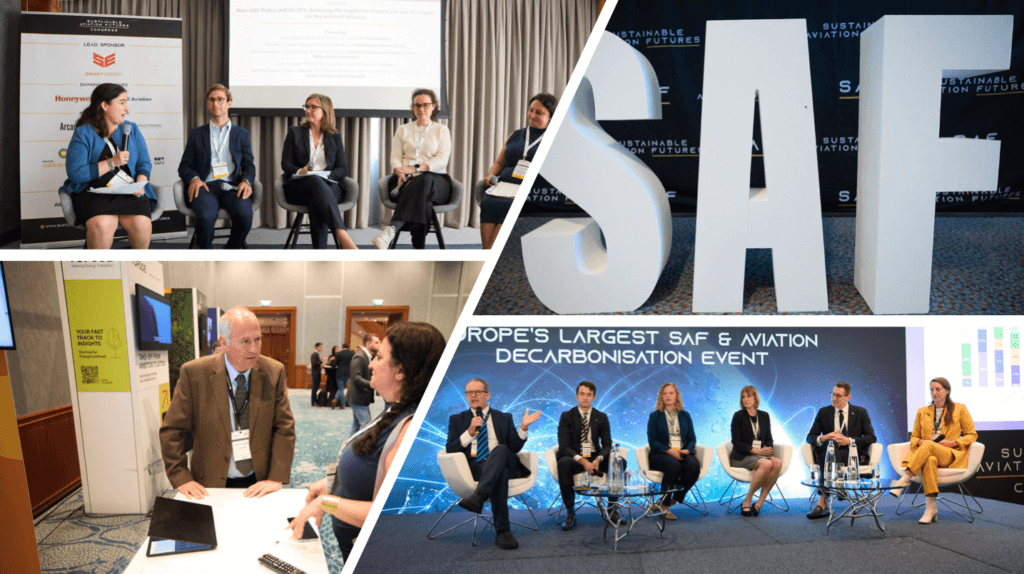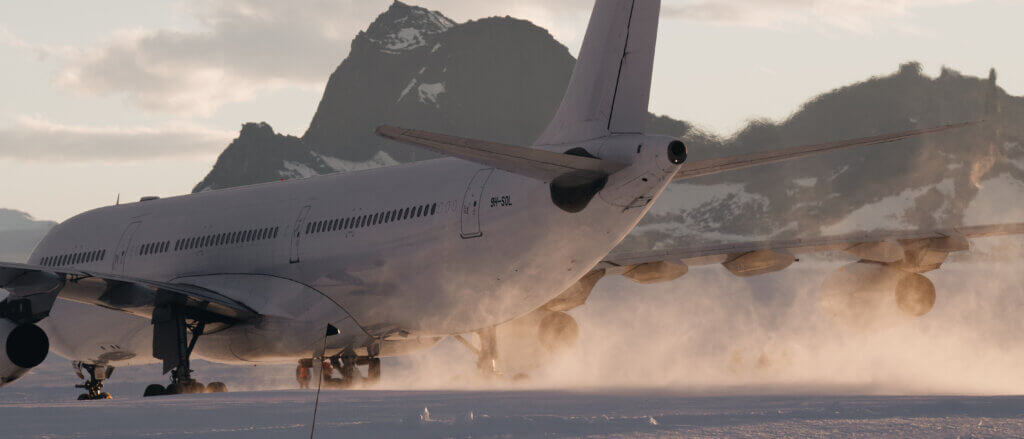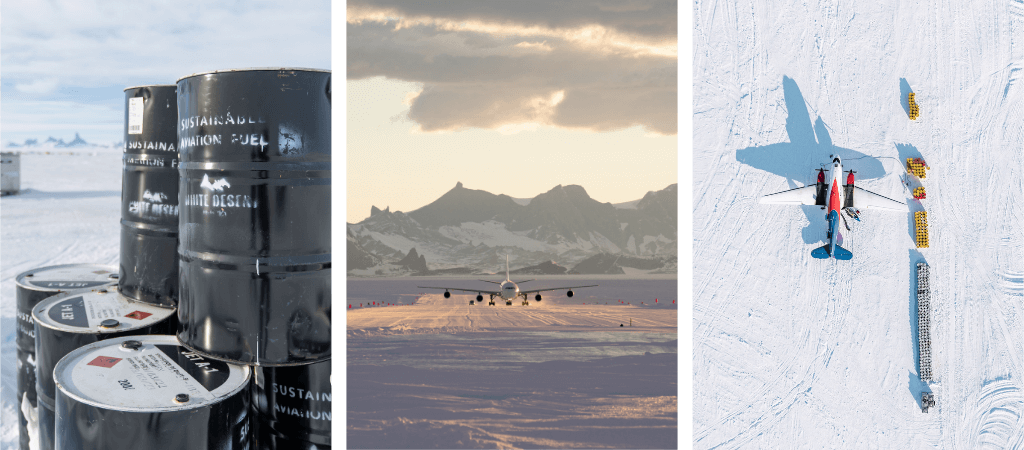Decarbonising Aviation: An interview with White Desert's Environmental Scientist, Eleni Antionades.
As a company founded by environmentally conscious, record-breaking explorers, we have always aimed to positively impact the landscapes we traverse. Operating in the pristine wilderness of Antarctica, we bear this profound responsibility and are dedicated to setting a benchmark for how tourism can operate sustainably in such a unique ecosystem.
White Desert has maintained a carbon-neutral status since 2007. Our commitment is reflected in our ambitious efforts, such as setting science-based targets aligned with the Paris Agreement and the UK’s “Net Zero by 2050” goal. In addition, we recently became the first Antarctic operator to trial Sustainable Aviation Fuel (SAF) on the 7th Continent—an achievement made possible by our Environmental Scientist, Eleni Antoniades.
At the end of May, Eleni represented White Desert at the Sustainable Aviation Futures Congress in Amsterdam, where she participated as a panellist in the #NonC02 Emissions Panel. The event gathered leading organisations and professionals dedicated to the decarbonisation of the aviation sector—an invaluable opportunity to share insights and discuss solutions that are being trialled across the industry.
We caught up with Eleni to hear a bit more about what was discussed at the event and how this impacts our operational future.

Talking NonC02 Emissions at Sustainable Aviation Futures Congress
1. Firstly, what are non-C02 emissions?
Non-CO2 emissions are other pollutants and greenhouse gases emitted by aircraft and other sources that contribute to climate change and environmental degradation but are not carbon dioxide (CO2).
In relation to aviation, these emissions include nitrogen oxides (NOx), soot (particulate matter), sulfur oxides (SOx) carbon monoxide (CO), unburned hydrocarbons (UHC), aerosols, and traces of hydroxyl compounds (-OH). Water vapour and soot contribute to contrail formation. The main climate change contributions from non-CO2 emissions of aviation arise from contrails and as well as from the chemical atmospheric reactions driven by NOx emissions.
2. Can you elaborate on how White Desert is decarbonising its aviation operations in Antarctica?
Reducing carbon emissions for an aviation-based organisation in Antarctica presents a complex technical challenge. Since aviation is the primary source of carbon emissions in our operations, and given Antarctica’s logistical and flight planning demands, even the most efficient aircraft can only lower emissions to a certain extent. For this reason, we have been actively incorporating Sustainable Aviation Fuel (SAF) as our primary method of decarbonising our aviation operations in Antarctica.
More specifically, White Desert has been exploring SAF produced from waste oils and greases, which can offer an 80% carbon saving over the product life-cycle compared to conventional jet fuel. The maximum permitted SAF blend is up to 50% and SAF blends of 30-50% will provide an overall carbon saving of 24-40%. Additionally, the use of SAF contributes to the circular economy and results in lower emissions of soot and SOx, which is crucial for maintaining Antarctic air quality.

Sustainable Aviation Fuel (SAF) offers notable environmental benefits regarding air quality
3. How is White Desert addressing the effects of non-C02 emissions?
While the primary focus of using Sustainable Aviation Fuel (SAF) is its reduction of carbon emissions, its environmental benefits extend further. As an environmental scientist, I am particularly interested in how SAF impacts contrail formation. Contrails form when soot and ice particles from aircraft emissions act as condensation nuclei in high-moisture atmospheres, sometimes creating contrail cirrus clouds that trap heat and contribute to atmospheric warming. Research indicates that SAF blends produce fewer contrails, with a 50-70% reduction in soot and ice particles and larger ice crystals, leading to less atmospheric warming. This highlights an additional benefit of SAF that warrants further research and consideration.
Sustainable Aviation Fuel (SAF) offers notable environmental benefits regarding air quality, including virtually no sulfur emissions and a significant reduction in particulate matter compared to JetA1. Additionally, there are indications of reduced nitrogen oxides, moderate reductions in carbon monoxide, and unburnt hydrocarbons during flight emissions testing. Research also shows that using SAF blends improves local air quality around airports compared to petroleum JetA1. While further research is needed, initial findings are very promising.
4. What examples or case studies were discussed?
I was excited to get the opportunity to present the latest information on White Desert’s SAF project in Antarctica and the importance of reducing the air quality impacts of our aviation operations. We also heard from Simone Rauer of Airbus, who discussed the numerous research and development projects Airbus is involved in regarding SAF emissions. This was particularly exciting for us as White Desert is the only operator in Antarctica that currently transports clients in a custom-fitted Airbus A340-300.
We hope the case study of the SAF project in Antarctica will build confidence for other operators in Antarctica to use SAF and show that even a small team or small-scale initiative can have a large sphere of influence.

White Desert was the first Antarctic Operator to purchase SAF for use in Antarctica.
5. Do these case studies influence legislative developments?
All activities in Antarctica are mandated to demonstrate a “less than minor or transitory impact on the environment” to proceed. This rigorous standard ensures the protection of the continent’s delicate ecosystem. White Desert, as an aviation-based organisation, has voluntarily set Science Based Targets to achieve Net Zero emissions. Utilising SAF is one of the critical mechanisms that contribute to these targets.
6. What does the future look like for decarbonising aviation in Antarctica?
Looking ahead, the plan is to expand the use of SAF across Antarctica, further enhancing the sustainability of aviation activities on the continent.
The importance and impact of sustainable aviation in Antarctica cannot be overstated and events like these provide invaluable opportunities to learn from other industry players and to help further decarbonise our aviation operations at White Desert.
By pioneering the use of SAF and other sustainable practices, White Desert is setting a benchmark for how tourism in Antarctica can operate responsibly in such a delicate ecosystem. Our efforts not only contribute to the global goal of decarbonising aviation but also ensure that we preserve the pristine beauty and ecological integrity of Antarctica for future generations.
About Eleni
 Eleni is an Environmental Scientist for aviation and infrastructure projects, with more than 20 years of experience in the Environmental Impact Assessment and environmental management of projects in challenging environments, such as Antarctica.
Eleni is an Environmental Scientist for aviation and infrastructure projects, with more than 20 years of experience in the Environmental Impact Assessment and environmental management of projects in challenging environments, such as Antarctica.
Recent achievements include launching the first use of Sustainable Aviation Fuel in Antarctica in 2021 and becoming Vice Chair of the first dedicated environmental science body at the UK Institution of Environmental Sciences in 2021.
Eleni is an Environmental Scientist, Chartered Environmentalist, Full Member and Vice President of the Institution of Environmental Sciences, where she established the EIA Community. Working with White Desert since 2016, she has helped shape the organisation’s environmental and sustainability strategy.
